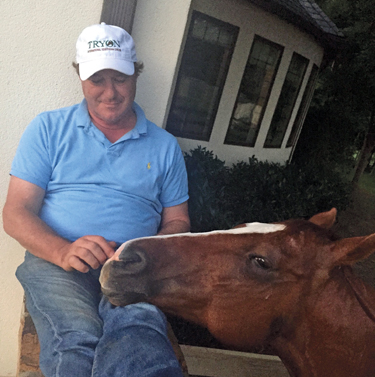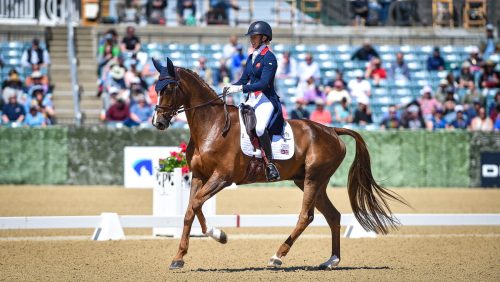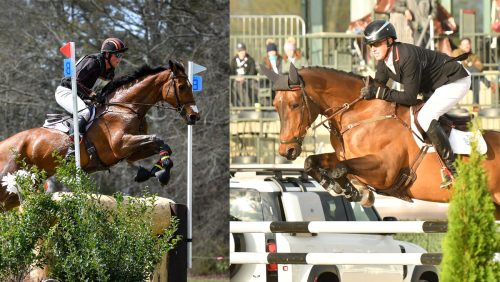The organizer of the Rolex Central Park Horse Show and managing partner of one of the largest show operators in the United States explores how to unify and amplify equestrian sports.
In a given year in the United States, there are 8 million people who ski, 23 million people who pick up a tennis racquet, 25 million who swing a golf club, and 27 million people who will ride a horse.
There is great interest and passion for horses and horse sport, but for many it’s considered a fringe, elitist, inaccessible activity. Horse sport is further complicated in that unlike skiing, golf and tennis, there are huge fragmentations of activity across many diverse disciplines and interests, albeit, with a common element: the horse.

Mark Bellissimo says the critical economic driver for the success of U.S. sport is spectatorship and sponsorship, such as Land Rover’s support of the Rolex Central Park Horse Show. “Without a strong sponsorship model, there’s no meaningful sustainable top sport in this country, and there’s no financial model for the riders,” he says. Photo by Ashley Neuhof
According to www.alexa.com, an Amazon company that tracks global websites within the sports segment, soccer has the most sites dedicated to it with 10,586 websites. Surprisingly, to many, equestrian is second with 5,779 websites (which is the embodiment of the 27 million people who ride a horse at least once in a year). Golf is close behind (5,700), along with skiing/winter sports (1,748) and tennis (1,430).
When presenting this fact to many sponsors they are shocked and become intrigued. The ultimate question for them is, “How do I tap into the 27 million people who enjoy horses?”
The fact is, it is very hard to do so. If you try to target enthusiasts within a horse sport discipline (jumping, dressage, polo, etc.) the numbers are small and rarely garner any major attention. So to be successful at the national level, your target audience shouldn’t be the discipline (e.g. jumping), but rather targeting the people who love horses, which I believe is a very large untapped market—but very hard to understand and access.
The best example of successful equestrian marketing is the Kentucky Derby, a simple to understand event, a horse race with a well-developed set of horse personalities, presented at the national level.
What’s Holding The Sport Back?
So despite the world’s largest economy, U.S. horse sport hasn’t reached its potential in terms of generating interest for participants, sponsors, and spectators.
What has contributed to this? Large numbers of U.S. sporting alternatives: urbanization converting horse farms into subdivisions, making entry level riding programs remote and less accessible; expense relative to other sporting options; limited spectator participation and events run more like county fairs than sports venues which inhibit traditional corporate sponsors; organizers with little incentive to promote spectatorship, as shows generate their primary income from the competitors; competition formats that can be confusing and boring to outsiders; lack of developed rider and horse personalities to inspire interest ; the formal attire of the athletes, and finally the lack of concentration of dates in geographic areas that forces participants to commit to a very expensive and socially disruptive “show tours.”
In most U.S. Equestrian Federation disciplines, the events are local, fragmented series of competitions, with certain regional and “national” championships often occurring in remote geographically dispersed temporary locations. The championships are most often broken up into pieces to “spread the wealth” among organizers who have a diverse level of resources and interests and, usually, very few spectators. These championships are not being used to generate interest in the sport outside of the industry. In my eyes, these events “preach to the choir” and provide little opportunity to grow interest in the sport.
ADVERTISEMENT
In fact, in most cases, there is very little incentive for an organizer to generate spectator, media and sponsorship interest beyond their own financial model. The presentation of the event and the development of the sport suffers beyond the immediate participants, which compromises growth. As a result, within equestrian sport, as many people are entering the sport as are exiting the sport. In many equestrian disciplines, actual participation is in decline because the preservation of the status quo has become more important than inspiring innovation in the design of the products.
All of these factors together limit participation in the sport, refinement of the product, spectatorship, and sponsorship, which limits the media coverage online, in print, and/or on air, which are critical elements to generating more interest in participation and therefore compromise the growth and sustainability of the sport.
Transitioning To Commercialization
With all of these obstacles before us, we face a scenario where to succeed as an athlete in top sport in the United States, you have to be independently wealthy, have a strong owner, or be extremely productive in horse acquisition and sales as a trainer to survive in the top level of the sport.
Sports such as skiing, tennis, and golf went through transitions from hobbies to professions in the United States through aggressive efforts by the athletes, organizers and governing bodies to commercialize the sport which increased exposure at the top levels of the sport and then created entry level interest in participating in the sport, which had the effect of growing the sports.
Most often that transition comes as a result of executing five steps: (1) structuring the event to ensure a high level of spectator interest; (2) aggressive promotion of the sport to the target market; (3) increased media coverage of the events and the development of participant personalities; (4) developing strong sponsorship relationships; and finally (5) developing a financial model so that the athletes and the organizers can both make money.
Currently few equestrian athletes in this country can generate their primary income through prize money. The critical economic driver for the success of U.S. sport is spectatorship and sponsorship. Without a strong sponsorship model, there’s no meaningful sustainable top sport in this country, and there’s no financial model for the riders.
There needs to be more productive collaboration between the top riders, event organizers and the governing bodies to create rider and horse “personalities” in the sport and a more engaging and marketable product that attracts media, spectators and sponsorship. Without personalities and interest in the sport, there is no media; if there is no media, there are no spectators, and if there are no spectators, there is no sponsorship, and if there is no sponsorship, there is no money to promote commercial sport.
We live in a society where instant gratification is highly desirable, and unfortunately, there is no silver bullet that will solve this problem overnight. For this transformation of U.S. horse sport to occur, I estimate it will take well more than 10 years.
But it will only work if show organizers, USEF and the FEI work together to create accessible and low-cost participation in the sport in order to create a pipeline of riders who aspire to participate in top sport; institute the highest standards for horse welfare; heavily promote rider and horse personalities; develop a model for attractive and entertaining events for spectators; and finally create a sponsorship model that provides the funding to maximize exposure to a broader audience.
The Central Park Model
The Rolex Central Park Horse Show was created to embody the five-step process outlined above. It’s an event that does not celebrate a single discipline; it celebrates the magic and power of horses across many disciplines and interests in one of the world’s most high-profile iconic locations, Central Park, which happens to be in the world’s largest media market, New York City.
ADVERTISEMENT
The event was free to competitors, with no stabling, show, feed, bedding or entry fees. The evening classes were sold out to spectators who valued the experience enough to pay $125 per ticket. Finally, the event generates hundreds of millions of impressions across The Chronicle of the Horse website, social media, and mainstream media outlets both in print and online as well as a 90-minute show on NBC Sports Network.
More than 30 sponsors value participation in the event including Rolex, Land Rover, Jet Blue, Canadian Pacific, Axel Johnson, Visit Florida and Adequan. Most have sponsored the show all three years, and this year’s event has attracted a record number of new requests from mainstream brands to sponsor the show next year.
The show culminated with a free family day on Sunday where thousands of spectators attended various equestrian demonstrations, and hundreds of children were able to ride ponies within the backdrop of the Manhattan skyline, have their faces painted, and participate in a mini Land Rover driving experience. The level of excitement was high, and the number of children having to get “extracted” from the ponies was frequent. “Mommy, I want to go again!” was a frequent cry.
Next year the show will expand with more disciplines, and more equestrian activity. It is one of the great opportunities to expose the public to equestrianism. The next step is to then to direct that interest to local programs that can satisfy the interest in horse sport.
All of us know that horses have an amazing ability to have both immediate and long lasting connections with humans. Those of us who work in the industry experience it every day; however, people are not going to search this out. We as event organizers, and as an industry, need to find innovative ways to bring horse sport to the people.
Critical to that strategy is to find low-cost ways for access and participation across all socioeconomic groups that have an interest in horse sport.
Again, I believe there is an amazing opportunity for horse sport in this country and abroad, but this requires many structural changes and much innovation—and must be supported by the governing bodies.
The Rolex Central Park Horse Show is just one example of the increasing number of high profile platforms that are emerging to promote equestrian sport nationally and globally. As a complement to this effort, I’m also hopeful that we are selected by the FEI and given the opportunity to run the 2018 FEI World Equestrian Games at Tryon International Equestrian Center (N.C.). We believe TIEC is the first year-round equestrian lifestyle destination dedicated to growing equestrian sport across all disciplines and critical dimensions: participation, entertainment, lifestyle, sport and commercial.
I’m confident we can present the sport uniquely and powerfully, exposing great horse and rider athletes to a broad global audience who can be captivated by the magic and majesty of the horse and, hopefully, inspire them to participate in this amazing world of equestrian lifestyle and sport.
 |
Mark Bellissimo is CEO of Wellington Equestrian Partners, who are owners of the world’s largest and longest running horse show, the Winter Equestrian Festival, as well as the Adequan Global Dressage Festival and International Polo Club in Wellington, Fla. He is also the managing partner of Tryon Equestrian Partners, which owns and operates the Tryon International Equestrian Center in Tryon, N.C., and the Colorado Horse Park in Parker, Colo. Mark and his wife Katherine own and operate International Equestrian Group, which produces the Rolex Central Park Horse Show and owns The Chronicle of the Horse, where Mark serves as its publisher. |














